19 Chapter 19: Homeostasis
Anastasia Chouvalova and Joshua Reid
Learning Objectives
By the end of this section, students should be able to:
19.1 For different examples of homeostasis, describe stimuli that disrupt the body’s equilibrium and describe the mechanisms (including organ systems involved) that return the body to equilibrium.
19.2 Explain why both negative and positive feedback loops are necessary to regulate different variables in living systems.
19.3 Describe multiple examples of how animals, other than humans, thermoregulate and osmoregulate.
Homeostasis
All living organisms share several key characteristics or functions: order, sensitivity or response to the environment, reproduction, adaptation, growth and development, regulation/homeostasis, energy processing, and evolution. In this chapter, we will focus on homeostasis in the context of organismal physiology.
Even the smallest organisms are complex and require multiple regulatory mechanisms to coordinate internal functions, respond to stimuli, and cope with environmental stresses. Animal organs and organ systems constantly adjust to internal and external changes through a process called homeostasis (“steady state”). Homeostasis (literally, “steady state”) refers to the relatively stable internal environment required to maintain life. Two examples of internal functions regulated in an organism are nutrient transport and blood flow. Organs (groups of tissues working together) perform specific functions, such as carrying oxygen throughout the body, removing wastes, delivering nutrients to every cell, and cooling the body. Homeostasis also aims to maintain proper levels of glucose or calcium in blood. Homeostasis means to maintain dynamic equilibrium in the body. It is dynamic because it is constantly adjusting to the changes that the body’s systems encounter. It is equilibrium because body functions are kept within specific ranges. Even an animal that is apparently inactive is maintaining this homeostatic equilibrium.
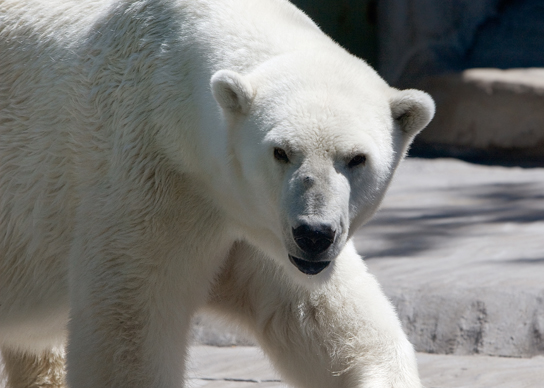
In order to function properly, cells require appropriate conditions such as proper temperature, pH, and appropriate concentration of diverse chemicals. These conditions may, however, change from one moment to the next. Organisms are able to maintain homeostatic internal conditions within a narrow range almost constantly, despite environmental changes, by activation of regulatory mechanisms. For example, an organism needs to regulate body temperature through the thermoregulation process. Organisms that live in cold climates, such as the polar bear (Figure 19.1), have body structures that help them withstand low temperatures and conserve body heat. Structures that aid in this type of insulation include fur, feathers, blubber, and fat. In hot climates, organisms have methods (such as perspiration in humans or panting in dogs) that help them to shed excess body heat.
Homeostatic Process
The goal of homeostasis is the maintenance of equilibrium around a point or value called a set point. While there are normal fluctuations from the set point, the body’s systems will usually attempt to go back to this point. A change in the internal or external environment is called a stimulus and is detected by a receptor; the response of the system is to adjust the deviation parameter toward the set point. For instance, if the body becomes too warm, adjustments are made to cool the animal. If the blood’s glucose rises after a meal, adjustments are made to lower the blood glucose level by getting the nutrient into tissues that need it or to store it for later use.
Control of Homeostasis
When a change occurs in an animal’s environment, an adjustment must be made. The receptor senses the change in the environment, then sends a signal to the control center (in most cases, the brain) which in turn generates a response that is signaled to an effector. The effector is a muscle (that contracts or relaxes) or a gland that secretes. Homeostatsis is maintained by negative feedback loops. Positive feedback loops actually push the organism further out of homeostasis, but may be necessary for life to occur. Homeostasis is controlled by the nervous and endocrine system of mammals.
Negative Feedback Mechanisms
Any homeostatic process that changes the direction of the stimulus is a negative feedback loop. It may either increase or decrease the stimulus, but the stimulus is not allowed to continue as it did before the receptor sensed it. In other words, if a level is too high, the body does something to bring it down, and conversely, if a level is too low, the body does something to make it go up. Hence the term negative feedback. An example is animal maintenance of blood glucose levels. When an animal has eaten, blood glucose levels rise. This is sensed by the nervous system. Specialized cells in the pancreas sense this, and the hormone insulin is released by the endocrine system. Insulin causes blood glucose levels to decrease, as would be expected in a negative feedback system, as illustrated in Figure 19.2. However, if an animal has not eaten and blood glucose levels decrease, this is sensed in another group of cells in the pancreas, and the hormone glucagon is released causing glucose levels to increase. This is still a negative feedback loop, but not in the direction expected by the use of the term “negative.” Another example of an increase as a result of the feedback loop is the control of blood calcium. If calcium levels decrease, specialized cells in the parathyroid gland sense this and release parathyroid hormone (PTH), causing an increased absorption of calcium through the intestines and kidneys and, possibly, the breakdown of bone in order to liberate calcium. The effects of PTH are to raise blood levels of the element. Negative feedback loops are the predominant mechanism used in homeostasis.
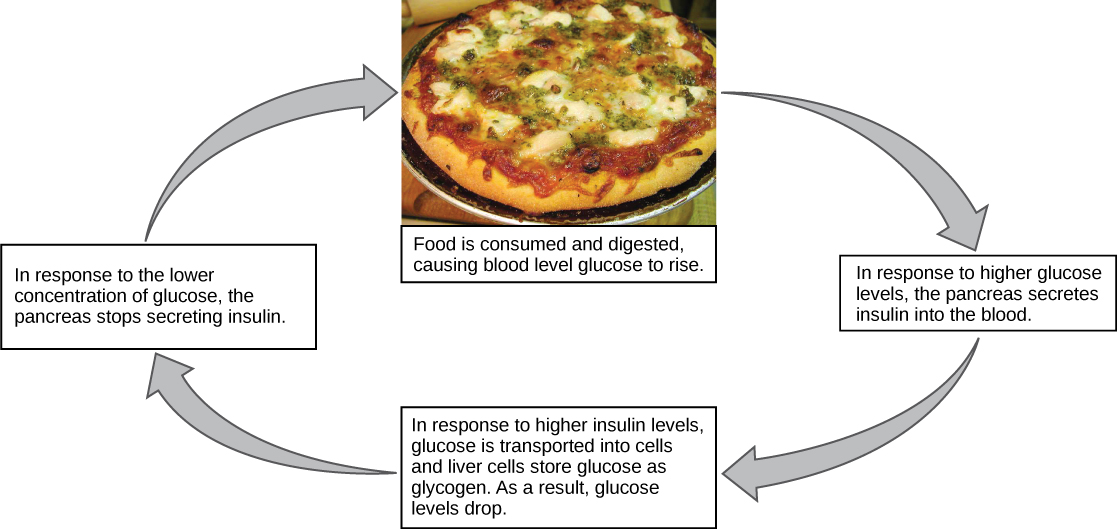
Positive Feedback Loop
A positive feedback loop maintains the direction of the stimulus, possibly accelerating it. Few examples of positive feedback loops exist in animal bodies, but one is found in the cascade of chemical reactions that result in blood clotting, or coagulation. As one clotting factor is activated, it activates the next factor in sequence until a fibrin clot is achieved. The direction is maintained, not changed, so this is positive feedback. Another example of positive feedback is uterine contractions during childbirth, as illustrated in Figure 19.3. The hormone oxytocin, made by the endocrine system, stimulates the contraction of the uterus. This produces pain sensed by the nervous system. Instead of lowering the oxytocin and causing the pain to subside, more oxytocin is produced until the contractions are powerful enough to produce childbirth.
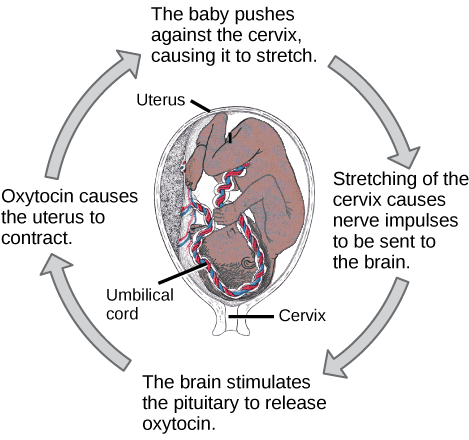
Reading Question #1
Recall the homeostasis section of Chapter 18. What controls homeostasis?
A. Positive feedback loops
B. Negative feedback loops
C. Neuro-endocrine system
D. All of the above
Reading Question #2
Which statement correctly describes the difference between positive and negative feedback loops?
A. Positive feedback aims to reduce the change and reset back to homeostasis, while negative feedback amplifies the change and takes the system further away from homeostasis.
B. Negative feedback aims to reduce the change and reset back to homeostasis, while positive feedback amplifies the change and takes the system further away from homeostasis.
C. Positive feedback aims to reduce the change and take the system closer to homeostasis, while negative feedback amplifies the change and resets the system back to homeostasis.
D. Negative feedback aims to amplify the change and reset back to homeostasis, while positive feedback reduces the change and takes the system further away from homeostasis.
Set Point
It is possible to adjust a system’s set point. When this happens, the feedback loop works to maintain the new setting. An example of this is blood pressure: over time, the normal or set point for blood pressure can increase as a result of continued increases in blood pressure. The body no longer recognizes the elevation as abnormal and no attempt is made to return to the lower set point. The result is the maintenance of an elevated blood pressure that can have harmful effects on the body. Medication can lower blood pressure and lower the set point in the system to a more healthy level. This is called a process of alteration of the set point in a feedback loop.
Changes can be made in a group of body organ systems in order to maintain a set point in another system. This is called acclimatization. This occurs, for instance, when an animal migrates to a higher altitude than that to which it is accustomed. In order to adjust to the lower oxygen levels at the new altitude, the body increases the number of red blood cells circulating in the blood to ensure adequate oxygen delivery to the tissues. Another example of acclimatization is animals that have seasonal changes in their coats: a heavier coat in the winter ensures adequate heat retention, and a light coat in summer assists in keeping body temperature from rising to harmful levels.
Link to Learning
Feedback mechanisms can be understood in terms of driving a race car along a track: watch a short video lesson on positive and negative feedback loops. Visit this link to view the video.
Reading Question #3
Match the following terms correctly to their definition.
A) Acclimatization. B) Set point. C) Homeostasis
- A system’s tendency to maintain internal stability.
- When organ systems alter their function in response to environmental changes to maintain balance and order within the body.
- The level at which a physiological parameter is most stable and conducive for proper bodily function.
Homeostasis: Thermoregulation
Body temperature affects body activities. Generally, as body temperature rises, enzyme activity rises as well. For every ten degree centigrade rise in temperature, enzyme activity doubles, up to a point. Body proteins, including enzymes, begin to denature and lose their function with high heat (around 50oC for mammals). Enzyme activity will decrease by half for every ten degree centigrade drop in temperature, to the point of freezing, with a few exceptions. Some fish can withstand freezing solid and return to normal with thawing.
Link to Learning
Watch this Discovery Channel video on thermoregulation to see illustrations of this process in a variety of animals.
Endotherms and Ectotherms
Animals can be divided into two groups: some maintain a constant body temperature in the face of differing environmental temperatures, while others have a body temperature that is the same as their environment and thus varies with the environment. Animals that rely on external temperatures to set their body temperature are ectotherms. This group has been called cold-blooded, but the term may not apply to an animal in the desert with a very warm body temperature. In contrast to ectotherms, poikilotherms are animals with constantly varying internal temperatures. An animal that maintains a constant body temperature in the face of environmental changes is called a homeotherm. Endotherms are animals that rely on internal sources for maintenance of relatively constant body temperature in varying environmental temperatures. These animals are able to maintain a level of metabolic activity at cooler temperature, which an ectotherm cannot due to differing enzyme levels of activity. It is worth mentioning that some ectotherms and poikilotherms have relatively constant body temperatures due to the constant environmental temperatures in their habitats. These animals are so-called ectothermic homeotherms, like some deep sea fish species.
Heat can be exchanged between an animal and its environment through four mechanisms: radiation, evaporation, convection, and conduction (Figure 19.4). Radiation is the emission of electromagnetic “heat” waves. Heat comes from the sun in this manner and radiates from dry skin the same way. Heat can be removed with liquid from a surface during evaporation. This occurs when a mammal sweats. Convection currents of air remove heat from the surface of dry skin as the air passes over it. Heat will be conducted from one surface to another during direct contact with the surfaces, such as an animal resting on a warm rock.
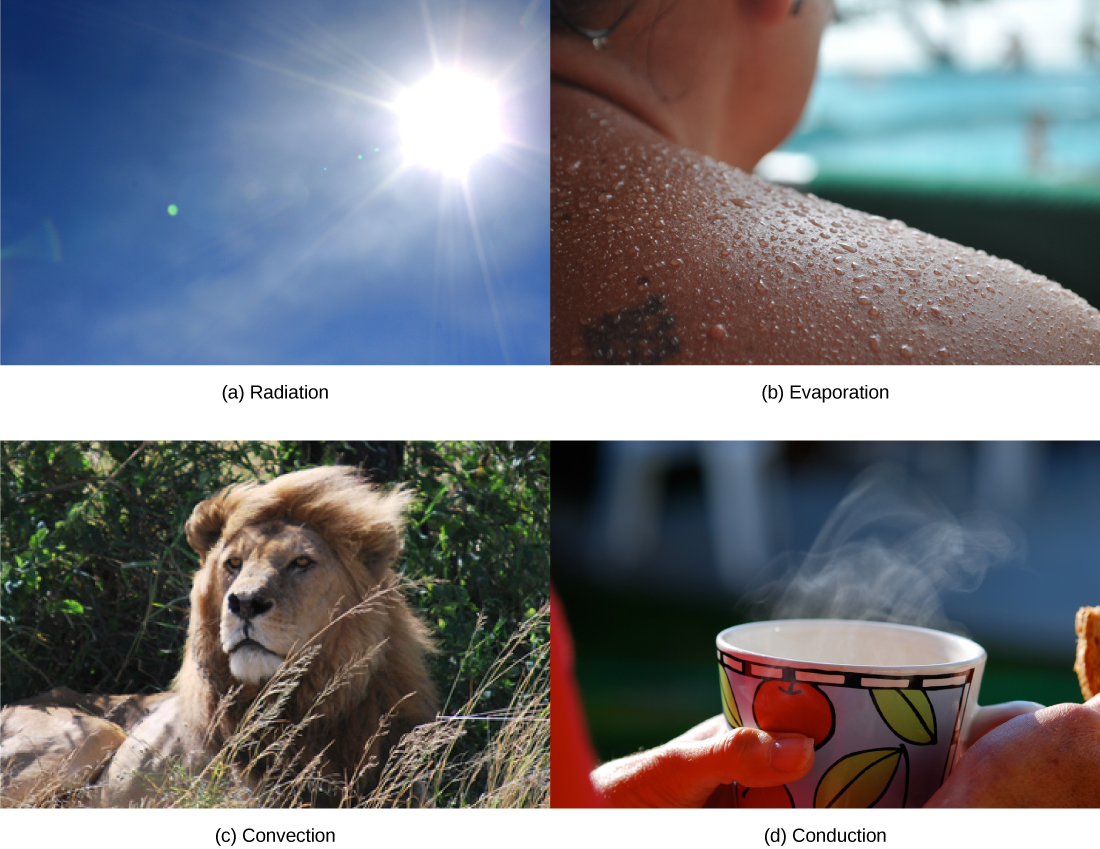
Heat Conservation and Dissipation
Animals conserve or dissipate heat in a variety of ways. In certain climates, endothermic animals have some form of insulation, such as fur, fat, feathers, or some combination thereof. Animals with thick fur or feathers create an insulating layer of air between their skin and internal organs. Polar bears and seals live and swim in a subfreezing environment and yet maintain a constant, warm, body temperature. The arctic fox, for example, uses its fluffy tail as extra insulation when it curls up to sleep in cold weather. Mammals have a residual effect from shivering and increased muscle activity: arrector pili muscles cause “goose bumps,” causing small hairs to stand up when the individual is cold; this has the intended effect of increasing body temperature. Mammals use layers of fat to achieve the same end. Loss of significant amounts of body fat will compromise an individual’s ability to conserve heat.
Endotherms use their circulatory systems to help maintain body temperature. Vasodilation brings more blood and heat to the body surface, facilitating radiation and evaporative heat loss, which helps to cool the body. Vasoconstriction reduces blood flow in peripheral blood vessels, forcing blood toward the core and the vital organs found there, and conserving heat. Some animals have adaptations to their circulatory system that enable them to transfer heat from arteries to veins, warming blood returning to the heart. This is called a countercurrent heat exchange; it prevents the cold venous blood from cooling the heart and other internal organs. This adaptation can be shut down in some animals to prevent overheating the internal organs. The countercurrent adaptation is found in many animals, including dolphins, sharks, bony fish, bees, and hummingbirds. In contrast, similar adaptations can help cool endotherms when needed, such as dolphin flukes and elephant ears.
Some ectothermic animals use changes in their behavior to help regulate body temperature. For example, a desert ectothermic animal may simply seek cooler areas during the hottest part of the day in the desert to keep from getting too warm. The same animals may climb onto rocks to capture heat during a cold desert night. Some animals seek water to aid evaporation in cooling them, as seen with reptiles. Other ectotherms use group activity such as the activity of bees to warm a hive to survive winter.
Many animals, especially mammals, use metabolic waste heat as a heat source. When muscles are contracted, most of the energy from the ATP used in muscle actions is wasted energy that translates into heat. Severe cold elicits a shivering reflex that generates heat for the body. Many species also have a type of adipose tissue called brown fat that specializes in generating heat.
Neural Control of Thermoregulation
The nervous system is important to thermoregulation, as illustrated in Figure 19.4. The processes of homeostasis and temperature control are centered in the hypothalamus of the advanced animal brain.
Visual Connection
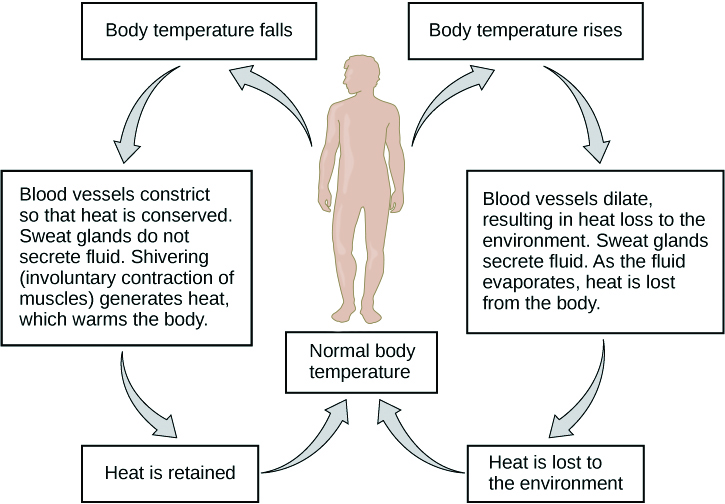
When bacteria are destroyed by leukocytes, pyrogens are released into the blood. Pyrogens reset the body’s thermostat to a higher temperature, resulting in fever. How might pyrogens cause the body temperature to rise? (Hint: Where in the brain does the thermostat reside?)
For more information and detailed answers, visit the embedded link.
El-Radhi A. S. (2019). Pathogenesis of Fever. Clinical Manual of Fever in Children, 53–68. https://doi.org/10.1007/978-3-319-92336-9_3
The hypothalamus maintains the set point for body temperature through reflexes that cause vasodilation and sweating when the body is too warm, or vasoconstriction and shivering when the body is too cold. It responds to chemicals from the body. When a bacterium is destroyed by phagocytic leukocytes, chemicals called endogenous pyrogens are released into the blood. These pyrogens circulate to the hypothalamus and reset the thermostat. This allows the body’s temperature to increase in what is commonly called a fever. An increase in body temperature causes iron to be conserved, which reduces a nutrient needed by bacteria. An increase in body heat also increases the activity of the animal’s enzymes and protective cells while inhibiting the enzymes and activity of the invading microorganisms. Finally, heat itself may also kill the pathogen. A fever that was once thought to be a complication of an infection is now understood to be a normal defense mechanism.
Reading Question #4
What is the most concerning effect of extremely hot or cold temperatures on organismal bodies?
A. Disruption in collagen integrity.
B. Disruption in enzyme shape and function.
C. Vasodilation may cause blood vessel rupturing.
D. Vasoconstriction may cause blood vessel collapse.
Reading Question #5
Which of the following statement(s) is/are true about fever?
A. Fevers have defensive purposes for the body because the heat can destroy causative pathogens.
B. Higher body temperatures induced by the fever decrease the activity of the affected organism’s enzymes and protective cells.
C. Higher body temperatures induced by the fever increase the activity of the affected organism’s enzymes and protective cells.
D. Higher body temperatures increase the availability of iron, which allows the causative pathogen to further proliferate.
E. Higher body temperatures induced by the fever decrease the activity of the pathogen’s enzymes.
References
Adapted from Clark, M.A., Douglas, M., and Choi, J. (2018). Biology 2e. OpenStax. Retrieved from https://openstax.org/books/biology-2e/pages/33-3-homeostasis?query=%22animal%20organs%20and%20organ%20systems%22&target=%7B%22type%22%3A%22search%22%2C%22index%22%3A0%7D#fs-idp55676512
ability of an organism to maintain constant internal conditions

